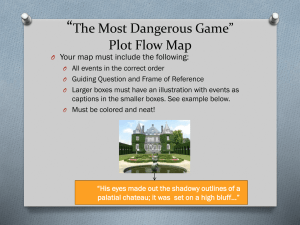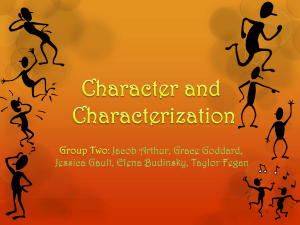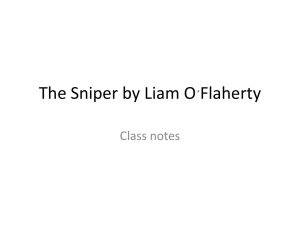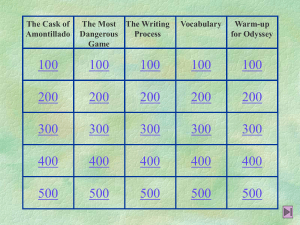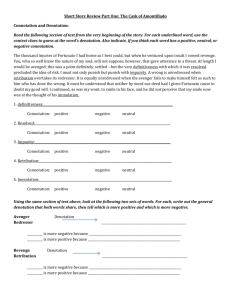Short Story and Literary Terms Project
advertisement
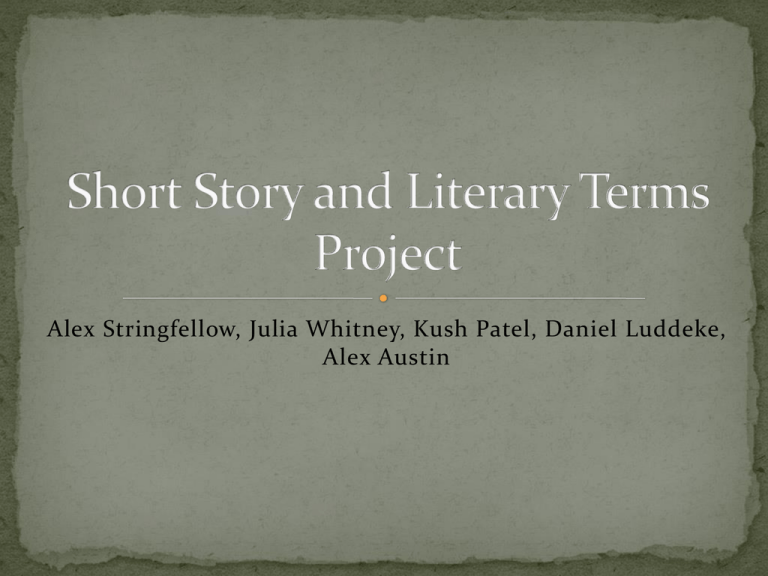
Alex Stringfellow, Julia Whitney, Kush Patel, Daniel Luddeke, Alex Austin Third Person Limited Point of View- We and the narrator knew Rainsford’s thoughts, feelings and emotions, through 3rd person. However, we only knew about the other characters personality and thoughts through dialogue and action. The point of view in this story enhances the effect of the ominous feeling by not knowing how Zaroff feels about his prey or the game he plays, while he is hunting. This is an example of the literary term as it explains the point of view and the knowledge of the narrator. Metaphor: An example of a metaphor would be in “The Most Dangerous Game” when Whitney is talking to Rainsford and he says, “’Sometimes I think evil is tangible’(18)”. This is an example of a metaphor because it’s describing evil as being tangible without using like or as and directly comparing it. Allusion: A reference to a statement, a person, a place or an event from literature, history, religion, mythology, politics, sports, science or pop culture. In the Story “Most Dangerous Game” General Zaroff makes an allusion referring to the Russian Revolution of 1917. “ After the debacle I left the country, for it was imprudent for an officer of the czar to stay there…” General Zaroff says to Rainsford during dinner. The debacle is referring to the revolution. Antagonist: The character or force that blocks the protagonist. In. the story “Most Dangerous Game” General Zaroff is the antagonist. He is the opposing force against Sanger Rainsford who is the protagonist. Flat Character: a character that has only one or two traits and these can be described in a few words. Whitney in the story “Most Dangerous Game” is a Flat Character, he can only be described In a few words and has only a few traits. Simile- “Ugh! It’s like moist black velvet” (18). -------Sanger Rainsford uses this simile to describe the moonless Caribbean night. You can tell it’s a simile because the quote uses the word like to describe the night as moist black velvet. Rainsford says this at the beginning of the story when he cannot see anything in the distance standing on the yacht. Stereotype- In “The Most Dangerous Game,” Zaroff shares the similar qualities of villains such as being well-educated, bored with life, wealthy, and immoral. Also, Zaroff is the head villain with brains while Ivan is the strongman who does the dirty work. Last, Ivan is the supporting villain who only listens to the main villain with no thoughts of his own. Suspense- Suspense is shown in “The Most Dangerous Game” throughout the first couple paragraphs, when ShipTrap Island is established as a mysterious island. Later, Rainsford hears a gunshot coming from the island and falls overboard. After he swims to the island and knocks on General Zaroff’s door, suspense is at its highest with the reader wondering who the man is. Also, when Rainsford is up on the tree and Zaroff has successful tracked him, he looks up to the top of the tree and blows a ring of smoke deliberately. The suspense builds as Zaroff gets closer and closer to Rainsford, finally looks up, and walks away with a smile. In the story, “Most Dangerous Game,” a character named Rainsford encounters many external conflicts. The main external conflict that Rainsford deals with throughout the story is that General Zaroff wants him dead. This is an external conflict since it is man versus man instead of man versus self. Plot Exposition- Setting(Year 2081), everyone is equal through handicap, tale of two parents whose son was taken for being too good (Harrison Bergeron). Rising Action- George and Hazel watch a ballet on TV, newsflash warning of Harrison’s escape, Harrison appears on screen. Climax- Harrison sheds his and his chosen empresses handicap and they begin to dance. When they reach the ceiling and are dancing, the Handicapper General storms in and shoots them both. Falling Action- George returns to living room (having missed the shooting) to find Hazel crying and she seemingly does not remember why. Resolution-Harrison is dead, Hazel we indirectly found out is very unintelligent, and George does not know what happened. In the story, “Harrison Bergeron,” the author characterizes George directly. He explains how George is intelligent in the third paragraph of the story. The author explains how he wears something in his ear to prevent him from taking an unfair advantage of his brain. This is direct characterizations since the author tells you what to think of George. The author says that George is intelligent. In the story, “Harrison Bergeron,” the author successfully creates a suspenseful and dramatic climax which keeps the reader on their seat. In the story, it is greatly detailed how the handicapper General storms in and kills Harrison and the ballerina. This is the climax of the story since it is has the most excitement than any other part. Third Person Omniscient-In this story you can tell what the woman is thinking while the boy stays at her house, but also the boy’s thoughts while he sits next to her bag. It is an example of third person omniscient, as we know the boys thoughts, as well as Luella Bates’ thoughts, from a third person point of view, and these are the only characters that we learn of in the book. This POV enhanced the feel of the story by knowing that the boy felt remorse while the lady felt a little bit sorry for him. Situational irony: An example of situational irony would be in “Thank You, Ma’am” when the boy tries to rob Mrs. Luella Bates Washington Jones and instead of successfully robbing her, she takes the boy in and feeds him dinner, makes him wash his face and gives him money for his blue suede shoes. It’s situational irony because you’d think that when someone robs someone, they wouldn’t take them under their wing to give them a lesson. http://www.imdb.com/video/wab/vi3096314905/ Simile-While Znaeym and Ulrich are trapped under the beech tree, Ulrich begins to forgive his former foe, Georg Znaeym, and states, “We have quarreled like devils(192)”. This shows that Ulrich is now remorseful and is condemning his actions. It is an example of a simile as it uses the word like, to compare to similar things. This simile enhances the story by adding a dark and strong elaboration of how they had quarreled. Dynamic character: a character who changes as a result of the stories events. In the story the “Interlopers” Ulrich von Gradwitz starts out in the story hating his neighbor Georg Znaeym and he wants to hunt him down in the woods. But when he finally finds him a tree branch falls on them and they are trapped together. During this time they reconcile and become friends again. Ulrich changing his views of his neighbor during the story and basically changing his way of life makes him a dynamic character. Tone- In “The Interlopers,” the tones are: ironic, suspenseful, and gloomy. It is ironic because of the ending when both men believe that Ulrich’s men are coming, but instead, when he gets a closer look at them, they are wolves. It is suspenseful because towards the end, when Georg and Ulrich are stuck under the tree waiting for their men to come and finally see them, the intensity builds up and everyone expects them to be rescued. In the end though, they are wolves. The tone is gloomy because the death at the end of the story makes it feel dark, and also the winter night makes it seem dark. First Person Point of View- In the short story, “A Cask of a Montillado”, A man named Montressor finds an enemy of his, Fortunato, and persuades Fortunato to come to his house to see an amontillado. When Montresor prepares to lead Fortunato, there is an excellent quote displaying first person point of view. “Thus speaking, Fortunato possessed himself of my arm. Putting on a mask of black silk and drawing a roquelaure closely about my person, I suffered him to hurry me to my palazzo(213)”. This quote shows that Montresor is going to take the man to his house and there is subtle sense of foreshadowing. It is an example of first person point of view, since Montresor is telling the story from his perspective and using personal pronouns such as I. This type of POV gives the story an even greater ominous feeling, as you can get an unhindered account of what happened leading up to the horrific murder. Foreshadowing: An example of foreshadowing would be in “The Cask of Amontillado” in the beginning when Monstresor says “The thousand injuries of Fortunado I had borne as best I could; but when he ventured upon insult, I vowed revenge(212)”. This is foreshadowing because it tells you that some time in the story, Montresor is going to get revenge somehow. Static Character: a character who does not change much in the course of a story. In the story “The Cask of Amontillado” Montressor wants to kill Fortunato for insulting him. Throughout the story he still wants to kill him, his attitude, appearance and state of mind never change so that makes him a static character. Unreliable Narrator- An unreliable narrator may purposely choose to deceive the reader, may speak in a certain tone or style, and his/her actions might be a sign to being an unreliable narrator. Montressor is an unreliable narrator because of how he purposely does not tell the reader everything he knows, not specifying why he is mad at Fortunato. In the story “Cask of Amontillado,” the narrator definitely knew how to set the dialect correctly since he wrote the story with an authentic Italian dialect. In the story, Montressor and Fortunato have conversations in a way that Italians would. They use vocabulary that is more common in Italy, and the way they speak makes them sound Italian. This is a prime example of dialect since it is a particular form of a language (English) that is peculiar to a specific region (Italy). The narrator introduces the story, “Cask of Amontillado,” by characterizing Montressor indirectly. “The thousand injuries of Fortunato I had borne as best I could; but when he ventured upon insult, I vowed revenge. You, who so well know the nature of my soul, will not suppose, however, that I gave utterance to a threat. At length I would be avenged; this was a point definitively settled—but the very definitiveness with which it was resolved precluded the idea of risk. I must not only punish, but punish with impunity” (211). This shows that Montressor is crazy and overdramatic since he longs for get revenge over an insult. Protagonist- In the short story by Liam O'Flaherty, called “The Sniper” the main character, a student, Republican sniper is the protagonist throughout the selection. This is inferred due to the fact that the story only focuses on him and his actions, and through the course of most of the story, he sees his actions as morally right. Because of this, the story is enhanced by letting us see the tale of the war, through the actions of a fanatic who believes in a free Ireland. Imagery: “The long June twilight faded into night. Dublin lay enveloped in darkness but the dim light of the moon that shone through fleecy clouds, casting a pale light as of approaching dawn over the streets and the dark waters of the Liffey(262)”. This quote from “The Sniper” is imagery because it describes Dublin at night in great detail. Dramatic irony: An example of dramatic irony would be in “The Sniper” when the Republican Sniper shot his target and it ended up being his brother. It’s dramatic irony because when you read the story, you’d think that they would be mortal enemies from the way things were being described, but his so-called “enemy” turned out to be his brother, which is something you wouldn’t expect. Round Character: is like a real person and has many different character traits, which sometimes contradict one another. In the story “The Sniper” Liam O’ Flaherty uses vivid description to describe the character traits of the sniper. “His face was the face of a student, thin and ascetic, but his eyes had the cold gleam of the fanatic. They were deep and thoughtful, the eyes of a man who was used to looking at death.” the narrator said about the sniper. This quote is just some of the description used to describe the sniper. In the story, “The Sniper,” the main character has a very good example of internal conflict towards the resolution of the story. The story explains how the main character feels remorse for killing the other sniper on the rooftop across from him. This is internal conflict since its man versus self because he’s having a difficult time dealing with the sad deed he completed. Theme- The theme is that everything in history is connected, and if one thing went differently the world would not be the same. When Eckels went out of the path and killed the butterfly, it changed the system of writing and Deutscher won the presidential election instead of Keith. This proves that if one slight change occurred, the world would be different today. Hyperbole: An example of a hyperbole would be in “A Sound of Thunder” when Travis says that if Eckles touches anything that is not on the path, then one thing would turn into another and before you know it, our whole future would be totally different. This is a hyperbole because Travis over exaggerates on what would happen if he touches anything in the past. Verbal irony: An example of verbal irony would be in “A Sound of Thunder” when Eckles says, “’Not a little thing like that! Not a butterfly!” This quote if verbal irony because you wouldn’t think that something like a butterfly would change the future, but according to Eckles, it did. Setting: “A Sound of Thunder” is set in an office in the present day and a “broad and high jungle” 60 million years ago. This is an example of setting as it describes where this short story is taking place. The great detail and description of the setting enhance the story by fully allowing us to picture the world with the dinosaurs that they are hunting. Analogy: Comparison made between 2 things to show how they are alike in some respects. An example of an analogy: Apple is to Fruit as Corn is to Vegetable. In this example 2 types of food are being compared. Great examples of flashbacks take place in the television show, Lost. In the program, people are stranded on an island and flashbacks occur from when they were not on the island. These are flashbacks since the story line pauses to view a previous point in time, then resumes to the normal story line.



